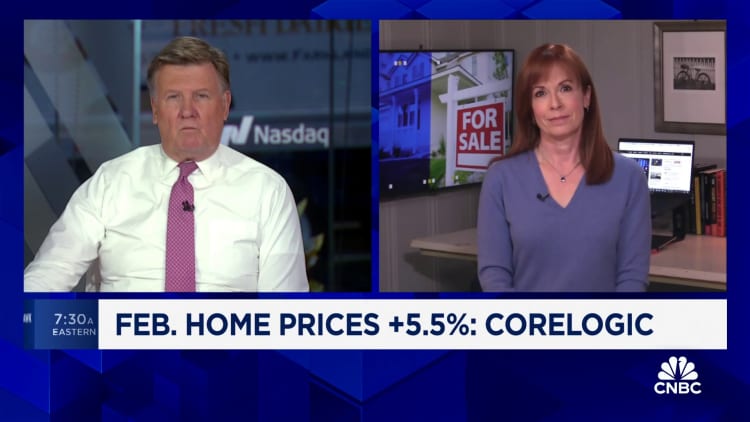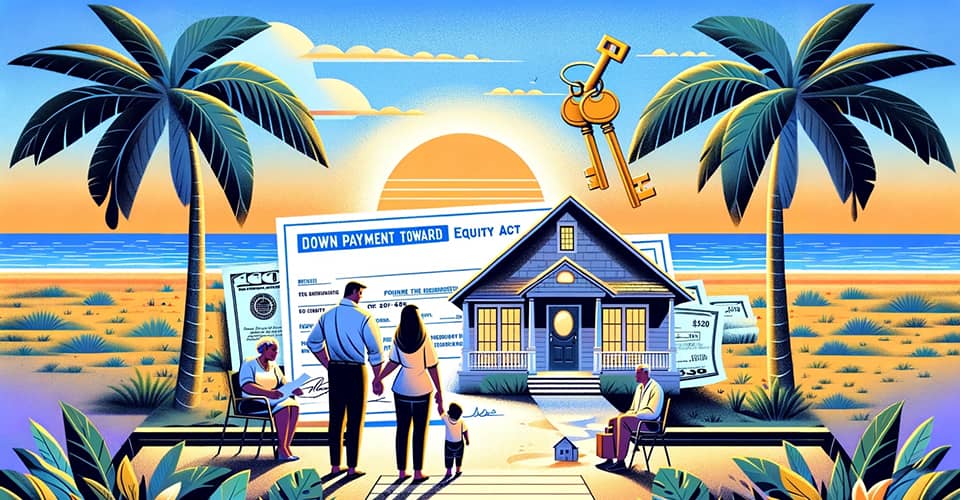The spring housing business is defying anticipations that price ranges would superior and competitors would simplicity.
Better property finance mortgage charges ordinarily cool each price ranges and wish, as they did ultimate yr, however that is not the scenario now. There are nonetheless far too couple of homes on the market as a result of current owners can’t discover the cash for to go, and it actually is retaining costs substantial.
Residence price ranges in February had been 5.5% greater than they’ve been in February of final 12 months, in accordance to CoreLogic. That once-a-year comparability is shrinking a little bit, however the price obtain from January to February was nearly two instances what it usually is for that point of 12 months, suggesting this spring’s market place began out potent regardless of greater curiosity costs.
The common price on the 30-calendar yr set residence mortgage strike its most present important in October, briefly crossing above 8%. It then dropped again once more into the 6% differ for a lot of December and all of January. It rose again greater than 7% in February, which actually ought to have cooled the sector.
But income of newly crafted properties, that are counted by contracts signed all through the month, ended up virtually 6% larger in February calendar yr over 12 months. Pending product sales of current residences, additionally depending on signed contracts, have been being down 7% that thirty day interval from the yr forward of, however not for absence of want.
Lock-in impression
The genuine points in trendy present residence present market is lack of present. There are extra new listings this spring than final, however supply is nonetheless 40% beneath wherever it was pre-pandemic.
That is partly since present-day house owners are affected by a lock-in impact: They is not going to itemizing their residences on the market for the cause that the price of transferring up is so excessive.
In the 22 yrs prematurely of the Federal Reserve commenced rising premiums in 2022, upgrading to a 25% way more expensive residence would have elevated the common house owner’s month-to-month cost of principal and want by 40%, or about $400 on frequent, in accordance to information from ICE Mortgage Technologies. Relocating to a equal family throughout the avenue wouldn’t enhance their cost in any respect.
In stark distinction at the moment, the regular house owner with a in shut proximity to report-small mortgage price would see their month-to-month cost shoot up 132%, or about $1,800, in buy to transfer up to a 25% way more expensive family. Buying the exact same dwelling they’re in now would increase their month-to-month cost by 60%, in accordance to ICE.
Those individuals improves signify countrywide averages and might fluctuate market to business. For living proof, transferring up would come with $604 to a house owner’s month to month cost in Buffalo, New York, an improve of 108% and $4,517 in San Jose, California, an elevate of 161%, in accordance to the ICE information.
“Lessen prices would ease the calculation for fairly a few and make strikes extra honest. But the internet consequence carries on to be far too quantity of properties for too tons of clients,” reported Andy Walden, ICE’s vice chairman of group evaluation. “Until that important mismatch is handled, quite simple supply and want will proceed to push on each inventory and affordability.”
What cost would unlock the market place?
If costs fell to 6%, the month to month cost increase to commerce up to a 25% additional expensive residence would relieve from a 103% frequent bounce to 88% – a modest however welcome enchancment, in accordance to Walden.
If premiums fell to 5%, going up would require a 68% bigger sized cost, however a nice deal greater than the extended-run typical of 39%, however maybe ample to encourage one other individual with a persuasive will want or want to improve.
While not all debtors have report-very low prices, additional do in expensive marketplaces as a result of the breakeven stage on the price tag of a refinance is typically diminished for higher-equilibrium debtors, in order that they have a lot extra incentive to do it. They additionally attainable have better-stability monetary loans, so relocating up to a larger price can be even costlier. That’s why the lock-in consequence is a lot better in considerably of California, the place houses are most costly.
The big overwhelming majority of debtors these days, 88.5%, have residence loans with prices beneath 6%, in accordance to Redfin. Around 59% have premiums beneath 4%, and close to to 23% of property homeowners have prices beneath 3%.
Those individuals shares are considerably decreased than they’ve been ultimate yr, just because some individuals did select to switch in the final 12 months, but it surely reveals what the sector is up in opposition to, significantly given important and still-growing home price ranges.
A brand new report from Zillow reveals the U.S. now has a history-high 550 “million-dollar” cities, or metropolitan areas the place the customary home is worth $1 million or further. That is 59 additional million-greenback cities than there have been in 2023, when dwelling values have been weakening thanks to rising home mortgage costs.



